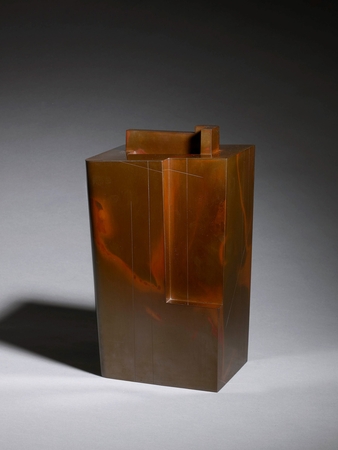Product Description
7509 A bronze flower vessel of rectangular form.
Japan 20th century Shōwa period *1987
Dimensions: H. 12¼” x W.5¼” x D.6¾” (H.31 cm x W.13 cm x D.17 cm)
Tomobako (original box) inscribed:
Lid: Shudō Henko (red bronze flask) Gai (Cliff)
Lid interior: Shūgorō
Seal: Shūgorō
Shūgorō Hasuda (1915-2010) was born in Kanazawa City, Ichikawa Prefecture and in 1928 entered the Ichikawa Prefectural Industrial School before continuing his studies at the Tokyo School of Art, graduating in 1938. He was invited to exhibit at the 5th Nitten (The Japan Fine Art Exhibition) in 1949 where his work received special recognition and in 1953 he received Nitten’s prestigious Hokuto prize and in 1959, he was awarded the Monbudaijinsho, a highly regarded prize given by the Minister of Education.
Hasuda participated in founding the Gendai Kōgei Bijutsuka Kyōkai (Creative Crafts Association) in 1961 and became an assistant professor at Tokyo University of the Arts in the same year. The following year, two of his pieces, with their instantly recognisable architectural form, were chosen as official gifts for the prime minister of West Germany and also the president of Mexico.
Hasuda received several commissions for large public sculptures and executed them following his philosophy of creating sculpture which interacts with its architectural environment. In 1976 Hasuda founded Nihon Kinzoku Zōkei Kenkyūjyo (The Japan Metal Sculpture Institute) and in 1980 his work was included in the exhibition Japanischen Metallbidner at the Museum fur Kunst und Gewerbe, Hamburg, Germany. Hasuda received the Japanese Order of Cultural Merit in 1991 and is considered one of the leading Post-war sculptors of Japan.
*This piece is accompanied by a certificate of authentication. The certification refers to when Hasuda was elected as Bunka Kōrōsha (a person of cultural merit) in 1987 and thirty examples of this work were made. Each was coated in copper oxide and the surface burnt with hard charcoal before polishing and patination leaving each peace with a unique final surface.
Works by the artist can be found in the collections of: Ishikawa Prefectural Museum of Art, Great People of Kanazawa Memorial Museum, Kanazawa; 21st century Museum of Contemporary Art, Kanazawa; The National Art Museum of Modern Art, Tokyo; Yamanashi Prefectural Museum of Art, Hiroshima Prefectural Art Museum, Museum of Contemporary Art Tokyo.








